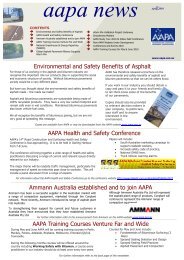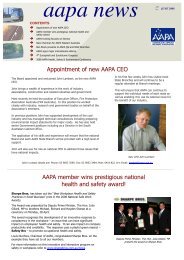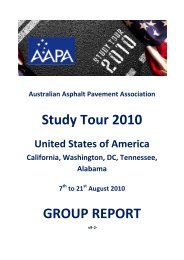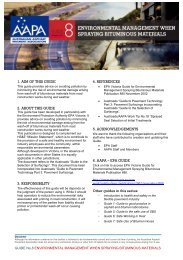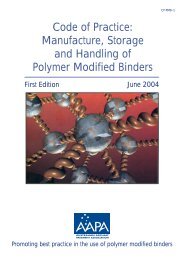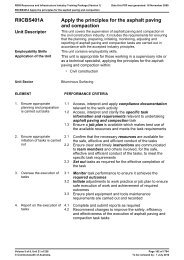Asphalt Review - Volume 29 Number 2 (June / July 2010)
Asphalt Review - Volume 29 Number 2 (June / July 2010)
Asphalt Review - Volume 29 Number 2 (June / July 2010)
You also want an ePaper? Increase the reach of your titles
YUMPU automatically turns print PDFs into web optimized ePapers that Google loves.
ASPHALT REVIEW<br />
southern hemisphere; CIAL supports any innovation that reduces<br />
the carbon footprint on a sustainable basis.<br />
CIAL has a rolling 20-year APMW program which makes it<br />
possible to look at paving opportunities that take advantage of<br />
these opportunities to trial several innovations.<br />
One of the innovations submitted to CIAL for approval was<br />
the trial CoolPave, on the airfield. Not only are there significant<br />
energy fuel savings, it is a much safer product to manage and<br />
compact. A trial section of CoolPave was laid on Taxiway A.<br />
Fulton Hogan laid 141 tonne (598m2) to a depth of 110mm<br />
on Taxiway A during February 2008. Subsequent testing and<br />
inspections of the CoolPave trial showed that CoolPave was<br />
as stable and as strong as the standard hot mix product used<br />
normally on the airfield.<br />
This first trial gave CIAL enough confidence to use CoolPave<br />
on a larger scale trial overlay on Taxiway F in February 2009.<br />
For this trial, 515 tonne (2,745m2) was laid. The full scale trial<br />
on Taxiway F is performing as designed. Testing and inspection<br />
are consistent with the small trial on Taxiway A. Handling the<br />
CoolPave was easier and much safer for the paving team than<br />
the standard hot mix product with no blue smoke and much<br />
lower temperatures.<br />
A smaller trial of 38 tonne using CoolPave with 30% Recycled<br />
<strong>Asphalt</strong> Pavement (RAP) was also completed on Taxiway F.<br />
The use of RAP reduces the amount of virgin binder required<br />
resulting in less cost and less fuel being used. The results of this<br />
trial are being assessed.<br />
CIAL is about to enter into a 5 year agreement with both<br />
Fulton Hogan and BECA to maximise the value of collaborating<br />
to reduce total cost of ownership in the delivery of APMW at<br />
CIAL. Part of this process is excelling at sustainable innovation<br />
for the benefit of all parties involved.<br />
CIAL is thrilled with the results from these trials. The trials<br />
pave the way for using CoolPave across more taxiway areas and<br />
possible trials on runway areas. CIAL will continue to work with<br />
Fulton Hogan on sustainable innovations within the APMW and<br />
any others areas within the Airport campus.<br />
7. Conclusions<br />
Recent advances have provided methods for the production of<br />
hot-mix asphalts at lower temperatures. These new production<br />
techniques have been termed “warm-mix asphalts” and more<br />
recent developments that further lower production and placement<br />
temperatures, “half-warm asphalts”.<br />
Fulton Hogan has implemented a “half-warm asphalt” technology<br />
under the CoolPave brand. Substantial tonnages of CoolPave-type<br />
half-warm asphalt pavements have been constructed in Europe<br />
and the United States. All evidence suggests that the CoolPave<br />
asphalt is at least as good as conventional hot-mix asphalt, if not<br />
better. Trials in New Zealand support these findings.<br />
There appear to be no technical barriers to the implementation<br />
of the CoolPave “half-warm” asphalt in New Zealand. There are<br />
economic constraints; plant upgrade and chemical costs are not<br />
insignificant. However, as fuel costs continue to rise, the economic<br />
barriers will disappear.<br />
It can sometimes be difficult to demonstrate the benefits of<br />
new technologies to clients. CoolPave is an exception to this; it<br />
is a manufacturing technique, which provides clients with a<br />
product essentially identical to conventional hot-mix asphalt. If<br />
there is a difference it is that the binder is aged less during the<br />
manufacturing processs.<br />
CoolPave half-warm asphalt is a significant advance in asphalt<br />
technology that provides benefits to the environment, the<br />
manufacturing and paving crews, the client and ultimately the<br />
tax-paying public.<br />
It is expected that hot-mix asphalts will be the exception in<br />
only a short time as evidenced by the substantial and enthusiastic<br />
uptake of half-warm asphalts in Europe and the United States.<br />
AAPA TRAINING COURSES FOR <strong>2010</strong><br />
Downloads of the<br />
<strong>2010</strong> program, course<br />
brochures, course<br />
outlines and course<br />
registration information<br />
are available from the<br />
website - www.aapa.<br />
asn.au/Training/AAPA<br />
Training Courses.<br />
If you require further<br />
information about courses<br />
or wish to discuss a<br />
customized course please<br />
contact:<br />
AAPA Training Centre.<br />
Phone: (03) 9853 5322<br />
Facsimile: (03) 9853 5914,<br />
E-mail: trainingcentre@<br />
aapa.asn.au<br />
Web: www.aapa.asn.au<br />
28 ROADS JUNE <strong>2010</strong>/JULY <strong>2010</strong>



